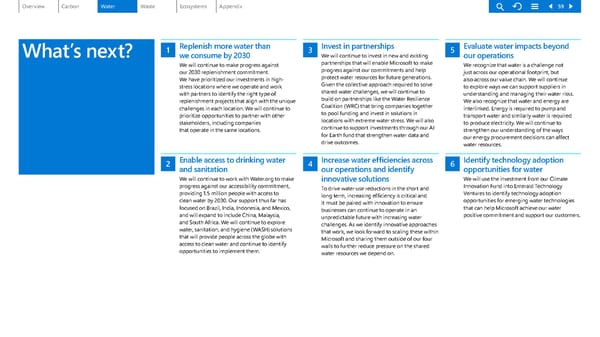What’s next? 1 Replenish more water than we consume by 2030 We will continue to make progress against our 2030 replenishment commitment. We have prioritized our investments in high- stress locations where we operate and work with partners to identify the right type of replenishment projects that align with the unique challenges in each location. We will continue to prioritize opportunities to partner with other stakeholders, including companies that operate in the same locations. 2 Enable access to drinking water and sanitation We will continue to work with Water.org to make prog ress against our accessibility commitment, providing 1.5 million people with access to clean water by 2030. Our support thus far has focused on Brazil, India, Indonesia, and Mexico, and will expand to include China, Malaysia, and South Africa. We will continue to explore water, sanitation, and hygiene (WASH) solutions that will provide people across the globe with access to clean water and continue to identify opportunities to implement them. 3 Invest in partnerships We will continue to invest in new and existing partnerships that will enable Microsoft to make progress against our commitments and help protect water resources for future generations. Given the collective approach required to solve shared water challenges, we will continue to build on partnerships like the Water Resilience Coalition (WRC) that bring companies together to pool funding and invest in solutions in locations with extreme water stress. We will also continue to support investments through our AI for Earth fund that strengthen water data and drive outcomes. 4 Increase water efficiencies across our operations and identify innovative solutions To drive water use reductions in the short and long term, increasing efficiency is critical and it must be paired with innovation to ensure businesses can continue to operate in an unpredictable future with increasing water challenges. As we identify innovative approaches that work, we look forward to scaling these within Microsoft and sharing them outside of our four walls to further reduce pressure on the shared water resources we depend on. 5 Evaluate water impacts beyond our operations We recognize that water is a challenge not just across our operational footprint, but also across our value chain. We will continue to explore ways we can support suppliers in understanding and managing their water risks. We also recognize that water and energy are interlinked. Energy is required to pump and transport water and similarly water is required to produce electricity. We will continue to strengthen our understanding of the ways our energy procurement decisions can affect water resources. 6 Identify technology adoption opportunities for water We will use the investment from our Climate Innovation Fund into Emerald Technology Ventures to identify technology adoption opportunities for emerging water technologies that can help Microsoft achieve our water positive commitment and support our customers. 59
 Environmental Sustainability Report | Microsoft Page 58 Page 60
Environmental Sustainability Report | Microsoft Page 58 Page 60